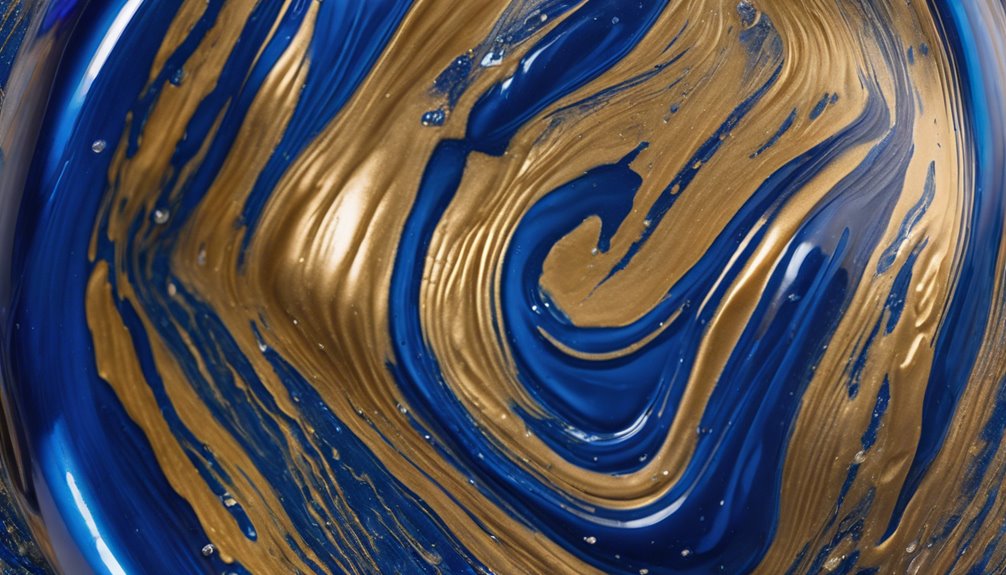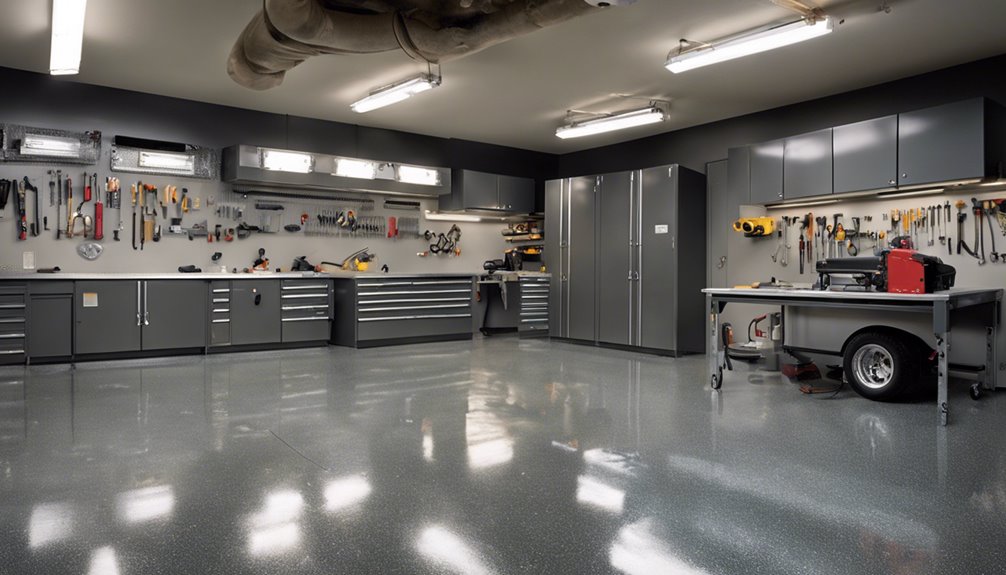To coat your garage floor with epoxy, start by gathering essential materials like the epoxy type, coating tools, and a concrete cleaner. Prepare the surface by cleaning it thoroughly to remove dirt and grease. After the floor dries, mix the resin and hardener as specified in the instructions. When applying, use a roller for even coverage and work in sections to maintain a wet edge. Allow proper curing based on temperature and humidity. Keep an eye on the weather to avoid rain. Following these steps carefully will lead you to a beautiful, lasting finish, and there's more to discover on maintaining it!
Gather Your Materials

Before you plunge into coating your garage floor with epoxy, it's vital to gather all the necessary materials. Start by choosing the right epoxy types—consider water-based for easy application or solvent-based for durability. Next, you'll need coating tools like a roller, brush, and squeegee for smooth application. Don't forget a paint tray and drop cloths to protect your surroundings. A concrete cleaner will help prepare the surface, while a mixing stick is essential for combining your epoxy components. Finally, having safety gear—gloves, goggles, and a mask—will keep you protected during the process. By assembling these materials beforehand, you're setting yourself up for a successful garage transformation that reflects your desire for freedom and creativity.
Prepare the Garage Floor
To guarantee your epoxy coating adheres properly, preparing the garage floor is essential. Start with surface cleaning to remove dirt, grease, and oil. Use a pressure washer or a scrub brush with a suitable cleaner for best results. Next, perform a moisture assessment to check for any moisture issues that could affect adhesion.
Here's a quick guide to help you:
| Step | Action | Purpose |
|---|---|---|
| Surface Cleaning | Pressure wash or scrub | Remove contaminants |
| Moisture Assessment | Tape a plastic sheet on floor | Check for moisture presence |
| Drying Check | Allow floor to dry completely | ascertain a solid foundation for epoxy |
Following these steps assures your garage floor is ready for the epoxy coating.
Mix the Epoxy Coating

Before mixing your epoxy coating, make sure you've gathered all the necessary materials, including the resin and hardener. It's essential to follow the mixing instructions precisely to achieve the right chemical reaction and durability. Pay attention to the consistency; it should be smooth and evenly blended for ideal application.
Gather Necessary Materials
Gathering the necessary materials for mixing your epoxy coating is essential to achieving a durable and long-lasting garage floor. Start by choosing the right epoxy types that suit your needs—some are designed for heavy-duty use, while others offer a sleek finish. Next, gather your coating tools, including a mixing bucket, a stir stick, and a paint roller with an extension pole for easy application. Don't forget gloves and safety goggles to protect yourself while working. Make sure you have a clean, dust-free space to mix your epoxy, as contaminants can affect the finish. Having all your materials ready will streamline the process, giving you the freedom to focus on creating a stunning garage floor you'll love.
Follow Mixing Instructions
Once you've got everything ready, it's important to follow the mixing instructions on your epoxy coating carefully. Getting this part right is vital for a strong, durable finish. Pay close attention to the epoxy ratios, as improper mixing can lead to issues later on. Use these mixing techniques to guarantee success:
- Measure each component accurately.
- Combine the resin and hardener in a clean container.
- Stir thoroughly for the recommended time.
- Avoid air bubbles by mixing gently.
Ensuring Proper Consistency
To achieve the best results with your epoxy coating, ensuring proper consistency during mixing is essential. Start by following the manufacturer's guidelines closely. Use epoxy consistency tips like measuring components accurately and mixing them in a clean bucket. Employ mixing techniques such as using a power mixer to blend the resin and hardener thoroughly, ensuring no streaks remain. Mix for the recommended time, usually about 3-5 minutes, to achieve a uniform texture. Remember, if the mixture's too thin, it won't adhere well; if it's too thick, it'll be hard to spread. Finding that sweet spot is vital for a durable finish. Once mixed, work quickly, as epoxy can begin to set fast, limiting your application time.
Apply the Epoxy
Applying the epoxy is a crucial step in achieving a durable and attractive garage floor. To guarantee a smooth process, keep these epoxy application tips in mind and avoid common mistakes:
- Use a roller for even coverage, avoiding brush strokes.
- Work in sections to prevent the epoxy from drying before you finish.
- Maintain a wet edge to blend each section seamlessly.
- Avoid puddles by spreading epoxy evenly and checking for high spots.
Allow to Cure Properly

Once you've applied the epoxy, it's essential to let it cure properly for best results. Aim for an ideal temperature range of 60°F to 90°F, as this can greatly affect the curing time and overall durability of the coating. Remember, rushing this process could lead to a weaker finish, so patience is key.
Ideal Temperature Range
When it comes to coating your garage floor with epoxy, understanding the ideal temperature range is essential for ensuring a proper cure. Ideally, you should aim for temperatures between 60°F and 90°F. Too cold or too hot, and you'll face unwanted temperature effects that can lead to issues like poor adhesion or cracking.
Keep these points in mind:
- Avoid extreme cold: Below 60°F can slow curing.
- Watch the heat: Above 90°F may cause bubbling.
- Humidity matters: High humidity can affect the finish.
- Check forecasts: Avoid applying before rain or snow.
Curing Time Importance
Curing time is a crucial aspect of your epoxy garage floor project that shouldn't be overlooked. Properly allowing the epoxy to cure guarantees a durable and long-lasting finish. The curing process can be influenced by several curing factors, including temperature, humidity, and the thickness of the application. Rushing this step can lead to peeling or cracking, so patience is key.
| Curing Factor | Ideal Condition | Impact on Curing |
|---|---|---|
| Temperature | 60°F – 85°F | Faster curing |
| Humidity | 40% – 60% | best adhesion |
| Application Thickness | 1/16" to 1/8" | Prevents pooling |
Maintain Your Epoxy Floor
Although maintaining your epoxy floor may seem challenging, it's actually quite manageable with the right approach. By following some simple epoxy maintenance tips, you can keep your floor looking pristine. Here are some effective cleaning procedures to contemplate:
- Sweep regularly to remove dirt and debris.
- Mop with a pH-neutral cleaner to avoid damaging the finish.
- Address spills immediately to prevent staining or slipping hazards.
- Use a soft-bristle brush for tough stains or scuff marks.
Frequently Asked Questions
Can I Apply Epoxy Over Existing Paint or Coatings?
You can apply epoxy over existing paint or coatings, but it requires careful preparation. Start with thorough surface cleaning; removing grease, dirt, and loose paint is essential for adhesion. Use a degreaser and a scrub brush, then rinse and dry the surface completely. Before applying epoxy, test a small area to verify compatibility. Following these epoxy preparation tips will help you achieve a durable, long-lasting finish, giving you the freedom to enjoy your newly coated space.
How Long Does Epoxy Flooring Typically Last?
Ever wondered how long your epoxy flooring's gonna last? Typically, epoxy flooring can endure 10 to 20 years, depending on factors like epoxy durability and maintenance tips. To maximize its lifespan, keep it clean and avoid heavy impacts. Regularly check for any wear or damage, and address it promptly. By taking these simple steps, you can enjoy a beautiful, long-lasting floor that enhances your space and provides the freedom to use it without worry.
Is Epoxy Coating Resistant to Chemicals and Stains?
Yes, epoxy coatings are known for their excellent chemical resistance and stain protection. When you apply epoxy to your garage floor, it creates a tough barrier that can withstand spills from oils, gasoline, and other harsh chemicals. This durability not only keeps your floor looking clean but also extends its lifespan. Just remember, while epoxy is resistant, it's still wise to clean up spills promptly to maintain its pristine appearance.
What Temperature Is Ideal for Applying Epoxy?
When applying epoxy, you'll want to aim for a temperature range between 60°F and 90°F. This guarantees peak adhesion and curing. If it's too cold, the epoxy might not cure properly, leading to issues down the line. Likewise, high temperatures can cause it to set too quickly, making application difficult. Always check your product's specific guidelines for the ideal application conditions to achieve the best results and enjoy a durable finish.
Can I Add Color or Decorative Flakes to the Epoxy?
They say, "A little paint goes a long way." When it comes to epoxy, you can definitely add color options and decorative flakes to personalize your floor. Just make certain to mix them in thoroughly to guarantee an even distribution. These additions not only enhance the aesthetic appeal but also increase durability. Remember, the right color and flakes can transform your space, giving it a unique touch that reflects your style!




